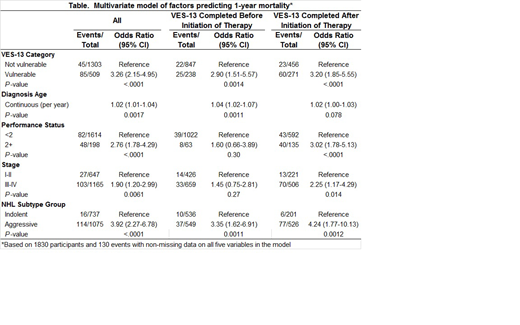Introduction. The VES-13 is a simple, self-reported, function based tool originally developed to screen community-dwelling populations to identify persons age 65 years and older at risk of death and functional decline, including death in the next 12 months. The VES-13 items include patient's age, self-rated overall health status, functional limitations in physical activity, and functional disabilities in more complex activities of daily living. As part of the Lymphoma Epidemiology of Outcomes (LEO) cohort study, we collected self-reported VES-13 data at study enrollment on all participants regardless of age, and here we report on the prevalence of vulnerable status defined by the VES-13 and its association with 1-year mortality, overall, stratified at age 65 years, and in the subset of diffuse large B-cell lymphoma (DLBCL) treated with immunochemotherapy.
Methods. From 7/2015 to 6/2017, 3253 participants with NHL were enrolled within 6 months of their diagnosis into the LEO cohort. 2004 were evaluable on VES-13, and 1183 (59%) completed it before the initiation of therapy. VES-13 scores range from a minimum of 0 (low risk for decline) to a maximum of 10 (greatest risk for decline), and a score ≥3 was classified as vulnerable. Clinical, pathology and treatment data were abstracted using a standard protocol, and participants were contacted every 6 months for the first three years and then annually thereafter to identify outcomes. Medical records were reviewed by LEO clinicians to classify cause of death according to a standard protocol. Therapy was determined by the treating physician, and this was independent of knowledge of the VES-13 score. The association of VES-13 with 1-year mortality from date of diagnosis was estimated using odds ratios (OR) and 95% confidence intervals (CI) from logistic regression models, which also provided model c-statistics.
Results. The median age of the 2004 participants in this analysis was 62 years (range 18-94); 57% were male; 54% were ≥65 years; and 28% had a normal body mass index (BMI), 1% were underweight, 35% were overweight, and 36% were obese. Clinically, 59% of participants had an aggressive subtype, 65% were stage III-IV, 24% had B-symptoms, and 11% had a performance status (PS) of ≥2. Overall, 28% of participants were classified as vulnerable (95% CI 26%-30%), with a higher prevalence among those completing the survey after initiation of therapy (38%, 95% 34%-41%) versus before initiation of therapy (22%, 95% CI 20%-24%), and a higher prevalence for those ≥65 years (32%, 95% CI 29%-34%) versus <65 (25%, 95% CI 22%-28%). During the first year of follow-up, there were 147 deaths, with 61% due to lymphoma, 14% therapy-related, 12% due to another malignancy, 3% other causes, and 10% unknown. Significant univariate predictors of 1-year mortality included vulnerable status, older age, PS 2+, stage III-IV, aggressive subtype, lower quality of life score, lower BMI, and 1 or more comorbidities, and were included the backward stepwise modeling. Vulnerable status (OR=3.26, 95% CI 2.15-4.96) was retained in the final model that also included age, PS, stage, and NHL subtype (Table), with a model c-statistic of 0.81. As shown in the Table, these associations were similar whether VES-13 was assessed before (c-statistic 0.77) or after (c-statistic 0.81) initiation of therapy. After adjustment for age, PS, stage and NHL subtype, vulnerable status predicted 1-year mortality in participants ≥65 years (OR=1.96, 95% CI 1.15-3.36; model c-statistic 0.80) as well as <65 years (OR=6.38, 95% CI 3.07-13.3; model c-statistic 0.83). Finally, in the DLBCL patients treated with immunochemotherapy (N=521), vulnerable status (38% of patients) also predicted 1-year mortality (OR=2.11, 95% CI 1.05-4.26) after adjusting for age, PS and stage (model c-statistic 0.78).
Conclusion. Based on a self-administered VES-13, 28% of newly diagnosed NHL patients in the LEO cohort were classified as vulnerable, including 25% of those <65 years, and vulnerable status was a strong predictor of 1-year-mortality, even in the subset of DLBCL patients treated with presumed curative intent. These results highlight the potential value of screening for vulnerable status overall and across a wider age spectrum in order to optimize patient management and reduce early mortality.
Martin:Karyopharm: Consultancy; Sandoz: Consultancy; I-MAB: Consultancy; Celgene: Consultancy; Janssen: Consultancy; Teneobio: Consultancy. Casulo:Gilead: Honoraria, Other: Travel, accommodation, expenses; Celgene: Research Funding; Roche: Other: Travel, accommodation, expenses. Cohen:Takeda Pharmaceuticals North America, Inc.: Research Funding; Bristol-Meyers Squibb Company: Research Funding; Hutchison: Research Funding; Astra Zeneca: Research Funding; Lymphoma Research Foundation: Research Funding; ASH: Research Funding; LAM Therapeutics: Research Funding; UNUM: Research Funding; Gilead/Kite: Consultancy; Janssen Pharmaceuticals: Consultancy; Seattle Genetics, Inc.: Consultancy, Research Funding; Genentech, Inc.: Consultancy, Research Funding. Farooq:Kite Pharma: Research Funding; Celgene: Honoraria. Friedberg:Acerta: Other: Data & Safety Monitoring Committee; Bayer: Honoraria, Other: Data & Safety Monitoring Committee. Kahl:Seattle Genetics: Consultancy; ADC Therapeutics: Consultancy, Research Funding; BeiGene: Consultancy; TG Therapeutics: Consultancy. Lossos:Janssen Scientific: Membership on an entity's Board of Directors or advisory committees; NIH: Research Funding; Seattle Genetics: Membership on an entity's Board of Directors or advisory committees. Maurer:Nanostring: Research Funding; Celgene: Research Funding; Morphosys: Membership on an entity's Board of Directors or advisory committees. Nastoupil:Spectrum: Honoraria; Genentech, Inc.: Honoraria, Research Funding; Gilead: Honoraria; Janssen: Honoraria, Research Funding; Novartis: Honoraria; TG Therapeutics: Honoraria, Research Funding; Bayer: Honoraria; Celgene: Honoraria, Research Funding. Rutherford:Heron: Consultancy, Honoraria; Janssen Scientific Affairs: Consultancy, Honoraria; AstraZeneca: Consultancy, Honoraria; Celgene: Consultancy, Honoraria; Juno Therapeutics Inc: Consultancy, Honoraria; Seattle Genetics: Consultancy, Honoraria; Verastem: Consultancy, Honoraria; Karyopharm: Honoraria, Membership on an entity's Board of Directors or advisory committees. Flowers:National Cancer Institute: Research Funding; BeiGene: Consultancy, Research Funding; Eastern Cooperative Oncology Group: Research Funding; Genentech, Inc./F. Hoffmann-La Roche Ltd: Consultancy, Research Funding; Pharmacyclics/Janssen: Consultancy, Research Funding; AbbVie: Consultancy, Research Funding; Bayer: Consultancy; Spectrum: Consultancy; Karyopharm: Consultancy; Acerta: Research Funding; TG Therapeutics: Research Funding; Millenium/Takeda: Research Funding; AstraZeneca: Consultancy; Optimum Rx: Consultancy; V Foundation: Research Funding; Celgene: Consultancy, Research Funding; Burroughs Wellcome Fund: Research Funding; Denovo Biopharma: Consultancy; Gilead: Consultancy, Research Funding. Cerhan:NanoString: Research Funding; Janssen: Membership on an entity's Board of Directors or advisory committees; Celgene: Research Funding.
Author notes
Asterisk with author names denotes non-ASH members.


This feature is available to Subscribers Only
Sign In or Create an Account Close Modal